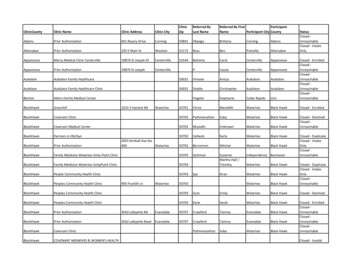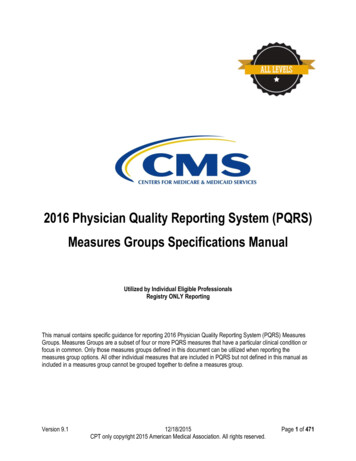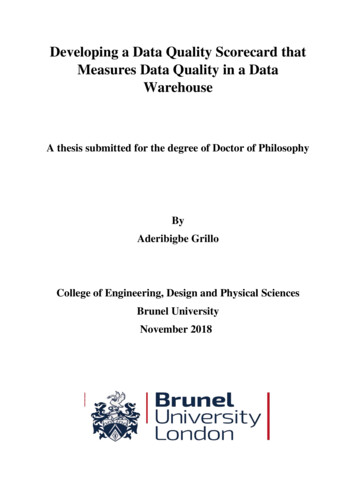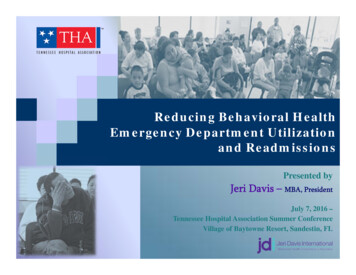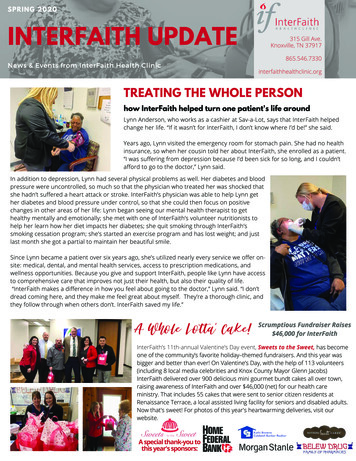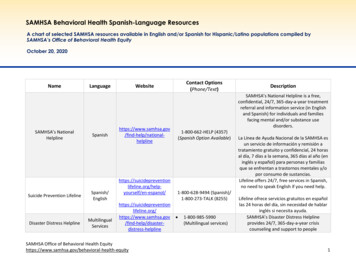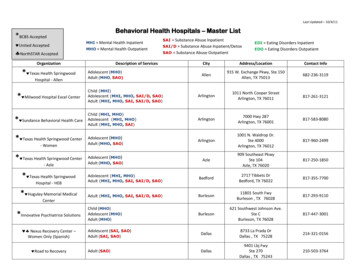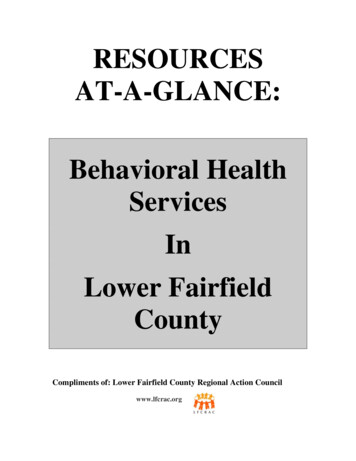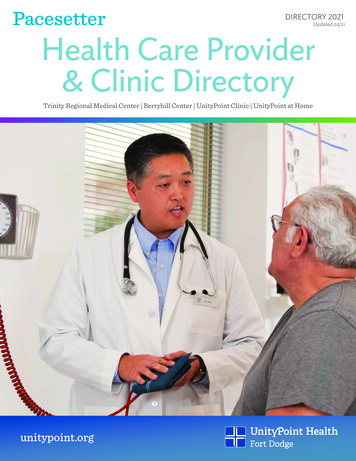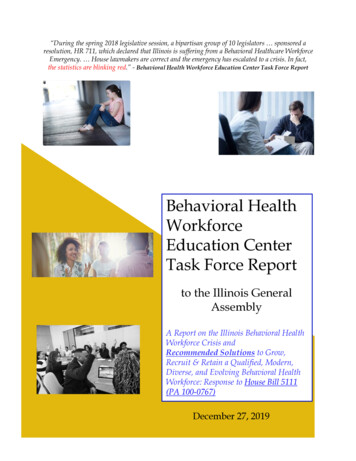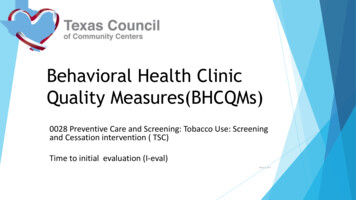
Transcription
Behavioral Health ClinicQuality Measures(BHCQMs)0028 Preventive Care and Screening: Tobacco Use: Screeningand Cessation intervention ( TSC)Time to initial evaluation (I-eval)March 2, 2017
Objectives of this webinarThe participants will be able to Describe Planwhat needs to be collected in these measureshow to gather and record data for the measures Identify processchanges which will need to occur ateach Center2
BHCQM SummaryWhereDocumented0028 Preventive Care & Percentage ofIndividuals with noMedical record.Screening: Tobaccoindividuals aged 18Tobacco Screening andMeans to extractUse: Screening &years and olderdocumentation thatand aggregateCessation Intervention screened for tobacco Tobacco Screening was not data needed. Can(TSC)use one or more times Performed due to one of be Electronicwithin 24 months AND the following reasons:health recordswho receivedMedical, not otherwise(including billingcessation counseling specified OR individualsrecords), paperintervention ifscreened for tobacco use health records, oridentified as aand identified as tobacco registrytobacco user.users, but did not receivea tobacco cessationintervention, reason nototherwise specified.MeasureTime to InitialEvaluation (I-Eval)SpecificsThe percent of newindividuals with initialevaluation providedwithin 10 businessdays of first contact,and the mean numberof days until initialevaluation for newindividuals. Data is tobe stratified by age(12-17; 18 and older).OmitThose seeking or requiringurgent or emergent care.(Only routine care iscounted in this measure).Who DocumentsNumeratorDenominatorDocumented by Care Patients who werePatients aged Coordinator,screened for tobacco18 years on dateDirect Care Staff, LVN, use at least once within of encounterMA, Prescribers, RN, or 24 months AND whowith at least oneLPHA Licensedreceived tobaccoencounter duringClinical Social Worker ( cessation intervention the reportingLCSW), Licensedif identified as aperiod (seeProfessional Counselor tobacco user. If not a cpt/hcpcs( LPC), Licenseduser are counted incodes).Marriage and Familynumerator.Therapist (LMFT)Medical record.No requirements.Means to extractdata andaggregate needed.1. Number of newNumber of newindividuals seekingindividualsservices who received seeking nonan initial evaluationurgent orwithin 10 business days emergencyof the first contact with services.the center. 2. The totalnumber of daysbetween the firstcontact and initialevaluation for allmembers of the eligiblepopulation seen at the3center during themeasurement period.FrequencyCommentsDenominator is Tobacco Use –theIncludes use of anymeasurementtype of tobacco.year and, for the Tobacco Cessationnumerator, isIntervention –theIncludes briefmeasurementcounseling (3 minutesyear and theor less), and/orprior yearpharmacotherapyOnce for eachnew individual.
0028 Preventive Care and Screening: Tobacco Use:Screening and Cessation intervention ( TSC)What outcome is being measured?Percentage of consumers aged 18 years and older who were screened fortobacco use one or more times within a year AND who received cessationcounseling intervention if identified as a tobacco user.Purpose/Benefit? Record the quality of services provided for preventive screening for tobacco use Screen at first contact and on a regular basis as tobacco use and motivation to quitchanges. Increased types and number of interventions produces better outcomes. Tobacco kills more than AIDS, heroin, cocaine, alcohol, car accidents, fire andhomicide – COMBINED. MI population accounts for ½ of all smoking deaths. Heavy smokers report substantially greater symptom burden and more functionaldisability compared to nonsmoking people seeking mental health treatment4(TSC)
What needs to be collected ? Tracked ? Age (18 ) at time of encounter Any Type of Tobacco Use Screening by Anyone: IdentifyUsers and Not Users. If multiple screenings are completedduring reporting period and one of them identifies individualas a User, that screening should be used in the report so youget credit for providing intervention. Cessation counseling intervention: Brief counseling and/orpharmacotherapy if individual is User Pay Source5(TSC)
What needs to be collected ?Eligible population Eligible encounter at the provider entity during themeasurement year (encounter code table follows) Aged 18 years and older on the date of service during themeasurement year Pay Source: Medicaid, dual eligible Medicaid & Medicare,and Other Exclude individuals with documentation of no tobaccoscreening performed because of limited life expectancy orother medical reason6(TSC)
Code Description90791 Psych Diag Eval NO Medical90792 Psych Diag Eval WITH Medical90832 Psychotherapy 16-37 minutes90834 Psychotherapy 38-52 minutes90837 Psychotherapy Over 53 minutes90845 Psychoanalysis96150 Health and behavior assessment (eg, health-focused clinical interview, behavioral observations, psychophysiological monitoring, health-oriented questionnaires)96151 Health and behavior assessment (eg, health-focused clinical interview, behavioral observations, psychophysiological monitoring, health-oriented questionnaires) re-assessment96152 Health and behavior intervention, each 15 minutes, face-to-face; individual97003 OT Initial Evaluation97004 Occupational Therapy Re-Eval99201 New PT Visit Level 199202 New PT Visit Level 299203 New PT Visit Level 399204 New PT Visit Level 499205 New Patient Exam Level 599212 Established PT Level 299213 Established PT Level 399214 Established PT Level 499406 Smoking and tobacco use cessation counseling visit; intermediate, 3-10 minutes99407 Smoking and tobacco use cessation counseling visit; intensive, greater than 10 minutesG0438 Annual wellness visit; includes a personalized prevention plan of service (pps), initial visitG0439 Annual wellness visit, includes a personalized prevention plan of service (pps), subsequent visit7
Performance Parameters & Interpretation Numerator/Performance Met: Consumer screened for tobacco useAND received tobacco cessation intervention (counseling,pharmacotherapy, or both), if identified as a tobacco userOR Numerator/Performance Met: Consumer screened for tobacco useand identified as a non-user of tobacco Performance Not Met: Tobacco screening OR tobacco cessationintervention not performed, reason not otherwise specified Interpretation of score: Better performance Higher percentage8(TSC)
Where to Record the information? Medical records: Electronic Health Record (including billingrecords) Paper Health Records Registry Excel spreadsheet Database Helpful for records to be stored in shared drive orchart9(TSC)
Each BHC will need to determine the following:Screening and Tobacco Cessation InterventionWhen does the tobacco screening/s take place?What tobacco cessation service/s was provided within 6 months ofindividual being identified as Tobacco User?Who will collect and document? Encounter documented by clinician Tobacco Screening can be provided by any staff Intervention can be provided by staff trained to provide briefcessation counseling and appropriate referrals for internal andexternal support and nicotine replacement pharmacotherapies.10(TSC)
Process change:1. Workflow: What changes are needed? Who and how will tobacco use and interventions be documented, trackedand monitored?2. Procedures/policies: Map out process detail including who is responsible to do what when Develop or revise existing procedures Identify changes in documentation process needed to capture this data Train staff early just before implementation Reports – track to see if you are meeting the measure3. Example: Test the system! See if what is planned works, or will there need to bechangesTSC PDSA cycles!11
What it will take to be successful. Train staff prior to implementation. Give them tobacco assessment tool,cessation resources, and develop tracking mechanism for referrals, cessationproducts, and tobacco cessation services. Determine how you will identify pay source Determine the way you will get the data in the required reporting template For further details, see pages 66-68 of BHCQMeasuresVol 1(508)1 & pages44-46 of BHCQMAppendicesVol 2(508)212(TSC)
Texas Behavioral Health Resources forTobacco Cessationwww.takingtexastobaccofree.com – Videos, posters,quit plans, handouts, and links to other websites877-YES-QUIT – www.yesquit.org - Free telephoneand online quit tobacco resources forTexans. Eligible participants may receive twoweeks of NRT. Online referral form for clinicians torefer people: http://www.yesquit.org/referralform/13
Time to Initial Evaluation (I-Eval)What outcome is being measured? The percent of new consumers with initial evaluation provided within 10business days of first contact, and the mean number of days until initialevaluation for new consumers. This is for people with “routine” non-emergent needs.Purpose/Benefit? Provides for better engagement of people with “glancing blows” to oursystem14(I-EVAL)
What needs to be collected ? Tracked ? First contact date (phone call or face to face) Initial evaluation provided by date (for the CCBHC) Provided: this means the initial evaluation was received 10 Business days: M-F excluding state and federal holidays For those seeking routine services Age New consumers: those not seen in the past 6 months Once for each consumer Payer15(I-EVAL)
What needs to be collected ?Eligible population – Age Stratification Two age stratifications and a total rate: 12-17 years as of the end of the measurement year 18 years and older as of the end of the measurement year Total ( both age groups)16(I-EVAL)
What needs to be collected ?Eligible population – Event/diagnosisTwo steps: Step 1: All new consumers seeking services during the first11 months of the measurement year Step 2: Aged 12 years and older as of the end of themeasurement year17(I-EVAL)
Two part Measure – Calculation OneMedical record Metric specification #1: The percentage ofNew consumers with initial evaluation provided within 10business days of the 1st contact Denominator: Number in eligible population Denominator Measurement Period (MP): Themeasurement year excluding the last 30 days of themeasurement year and including the 6 months preceding themeasurement year Numerator: Number receiving initial evaluation within 10business days of the 1st contact during the measurement year Numerator MP: The measurement year18 Why? To assure initial evaluation in 10 days(I-EVAL)
Two part Measure – Calculation TwoMedical record Metric specification #2: The mean (averagenumber of days) until initial evaluation for new consumers Denominator: Number in eligible population Denominator Measurement Period: The measurement yearexcluding the last 30 days of the measurement year andincluding the 6 months preceding the measurement year Numerator: Total number of days between first contact andinitial evaluation for all in the eligible population seen at theprovider in the measurement year Numerator MP: The measurement year. Why? To assure initial evaluation in 10 days19(I-EVAL)
Interpretation of Scores – Why do this? Percentage of new consumers with initial evaluationprovided within 10 business days: Better performance Higher score Mean number of days until initial evaluation for newconsumers: Better performance Lower number20(I-EVAL)
Recognized limitation of I-EVAL It is likely some new consumers will not have anappointment within 10 days because of their ownschedules and non-urgent need. This situation is a recognized limitation of thismeasure that will affect all clinics. Trying to adjust for non-consumers who are offeredbut do not accept an appointment within 10 businessdays complicates the calculation unnecessarily.21(I-EVAL)
Where to Record the information? Medical records. Potential sources:Electronic Health Record (including billing records)Paper Health RecordsExcel spread sheetDatabaseRegistryElectronic Scheduling system: separate from themedical record, but used to schedule and monitorappointments and time frames22(I-EVAL)
I-EVAL Open Access Question from SAMHSAIf a program has, where clients can come in where ever they wantduring certain hours, but they happen to call first to determine whenopen access hours are, if that call considered first contact? No, a call to determine when open access hours are held is not firstcontact unless that call is accompanied by the preliminary screening andrisk assessment, and collection of basic data about the person, includinginsurance information, In general, however, if a person calls just to findout what hours you are open that is not an initial contact. That is anattempt to come in and find out when they can have an initial contact.If a consumer calls seeking an evaluation and we provide them withour own open access and they never show, is that counted in thedenominator? Yes, assuming your provided the preliminary screening and riskassessment to ascertain level of acuity when they called.23(I-EVAL)
Each BHC will need to determine the following:Initial ContactWhen does the initial contact take place? A phone call Registration Clinic visit MCOTWho will collect and document ? No requirements/restrictions as to who completes the initial contact First contact is simply the first contact Need to determine where you want it documented so you can pullthe data24(I-EVAL)
Each BHC will need to determine the following:Initial EvaluationWhen does the initial evaluation take place? The initial evaluation is the one meeting standards for CCBHC Clinic visit Access to careWho will collect and document ? Initial evaluation is done by an LPHA, a prescriber or a QMHP inconjunction with the LPHA or Prescriber’s evaluation Need to determine where you want it documented so you can pullthe data25(I-EVAL)
Process change:1. Workflow: Will it have to change? Ways you document, track and monitor – do they need to change2. Procedures/policies: Think of all the steps in the process. Is there an actual proceduredocumenting this? Will you need to amend the documentation process to capture this data Reports – track to see if you are meeting the measure3. Example: Test the system! See if what is planned works, or will there need to bechanges PDSA cycles!26(I-EVAL)
Appendix for I-eval Metrics and Quality Measures for Behavioral Health Clinics:Technical Specifications and Resource Manual – Volume Two Review pages 27-31 for detailed examples of I-Eval27(I-EVAL)
What it will take to be successful. Designate a staff team responsible to get the process done Protocols and procedures facilitate a consistent process Train staff – Test the plan! This is about your documentation system beingable to track and stratify the particulars of the measure. Staff are having an initial contact now – How do you document and trackwhen that occurs? Staff are providing an initial evaluation now – What is the best way to link thatinitial contact to the initial evaluation and track it?28(I-EVAL)
Revised Webinar ScheduleWebinars: Will send out revised registration29
Remember Start planning assessment and collection methods now. Baseline period begins 7/1/17 (aligns with proposed DSRIP baseline) Data reporting for measurement year 1/1/18Resources: Texas Council Website (BHCQM volume 1 and 2, FAQs, template, hp/texas-council-initiatives/ccbhc/30
(TSC) Percentage of individuals aged 18 years and older screened for tobacco use one or more times within 24 months AND who received cessation counseling . LVN, MA, Prescribers, RN, or LPHA License
